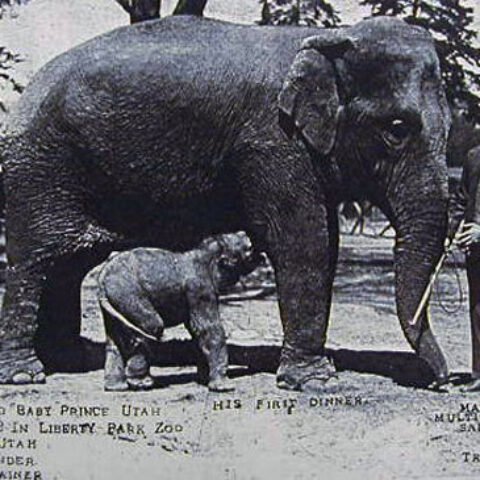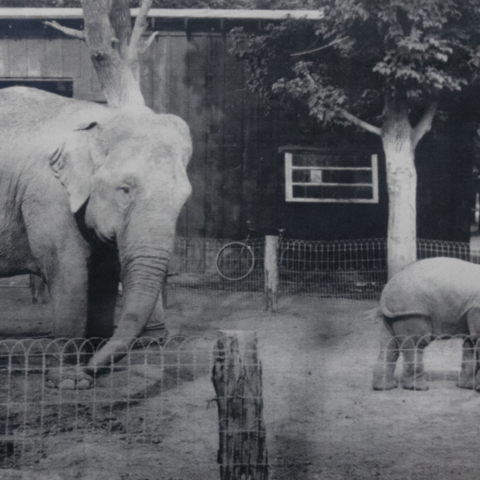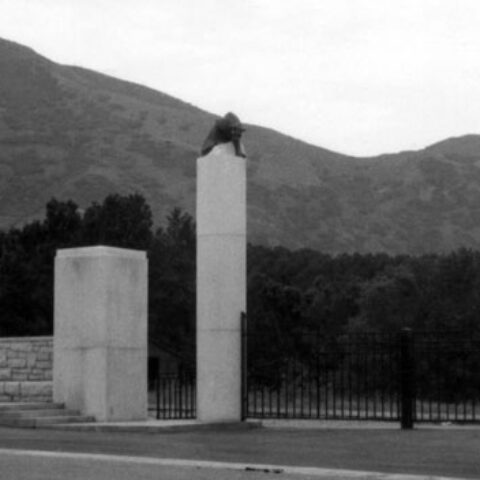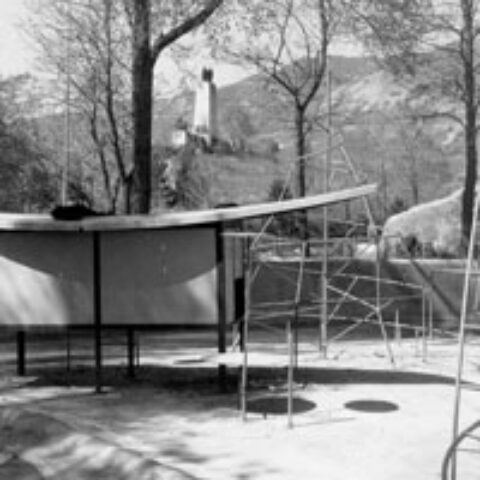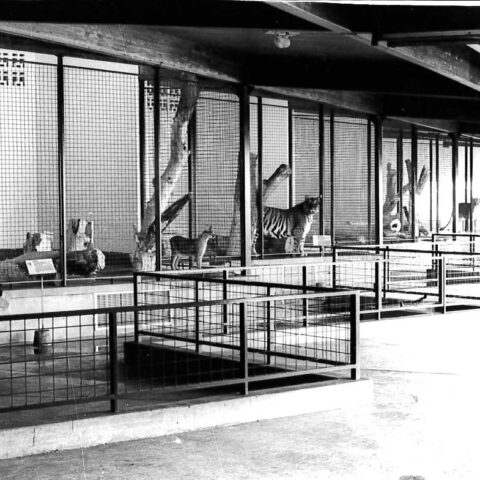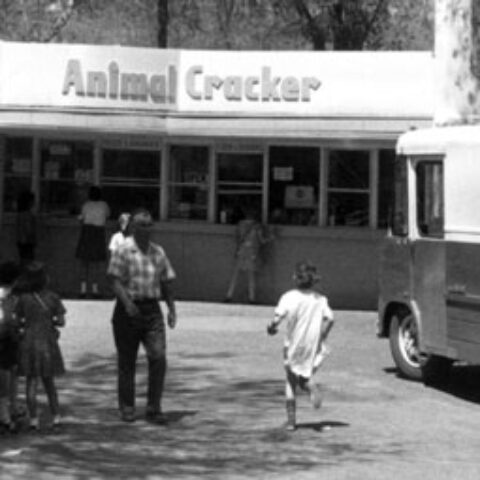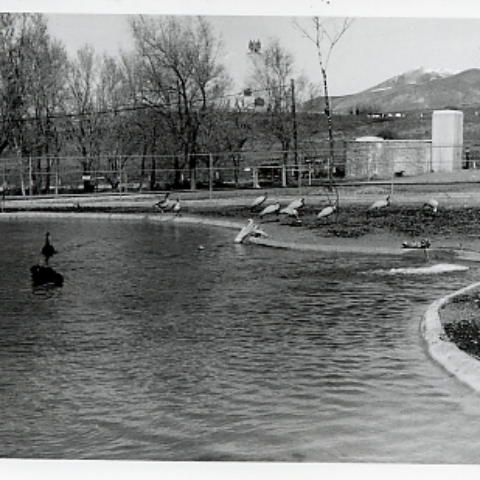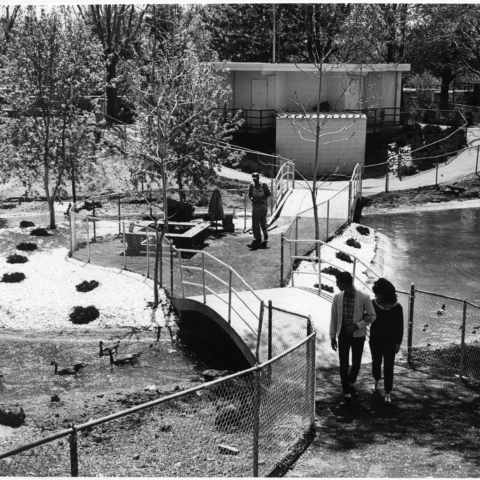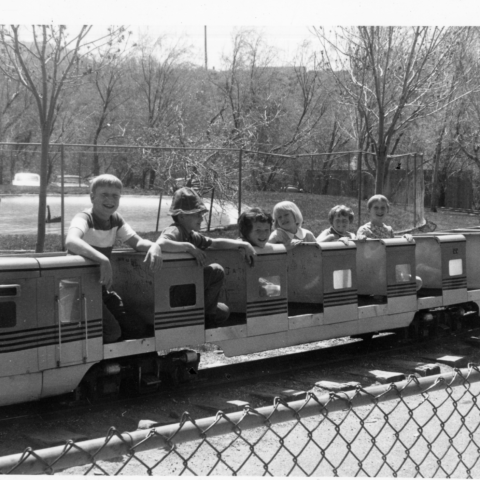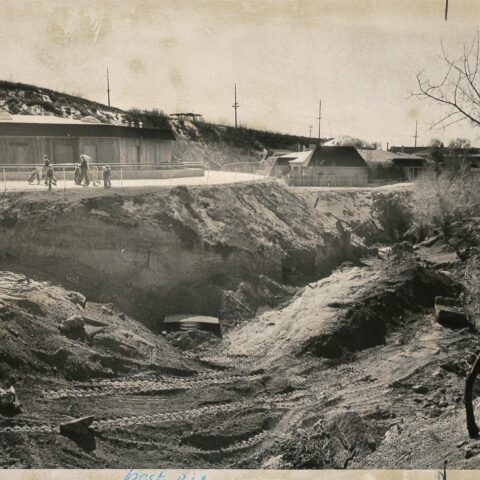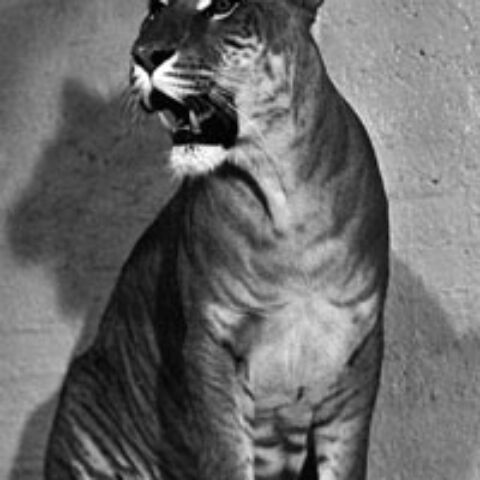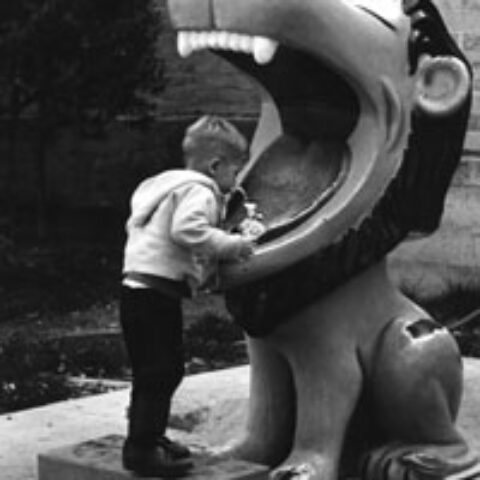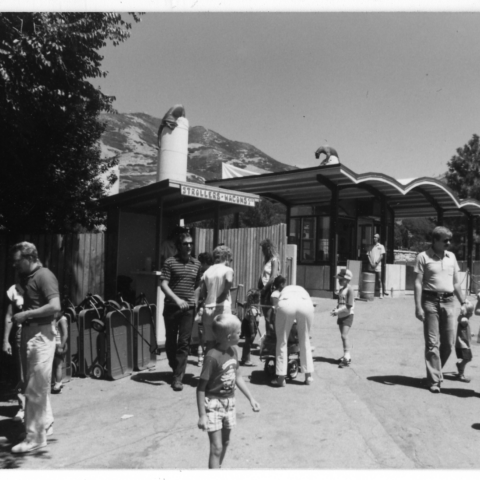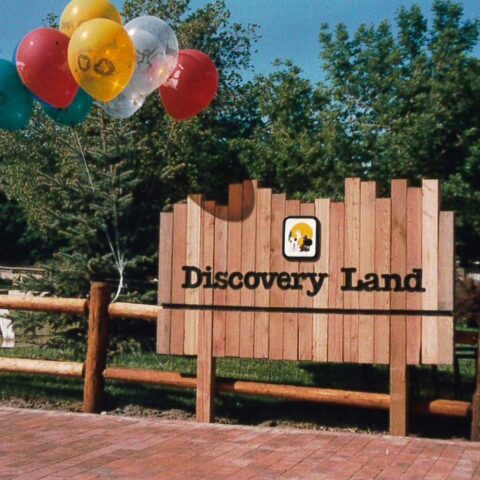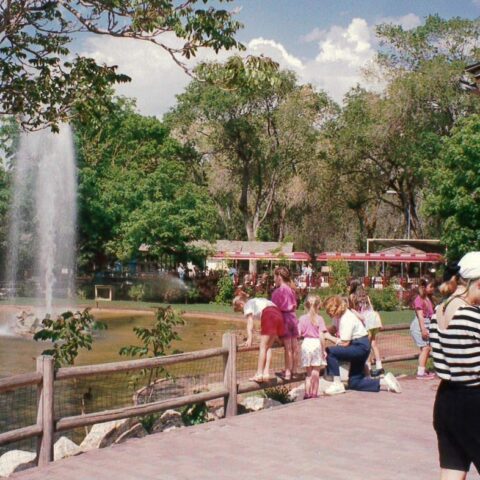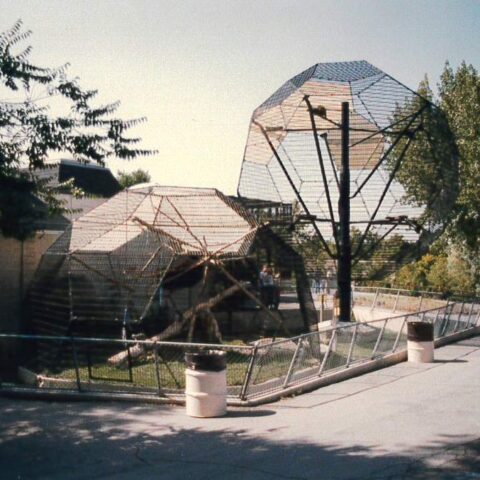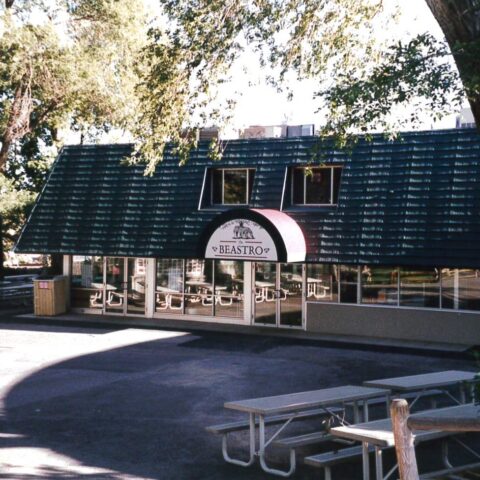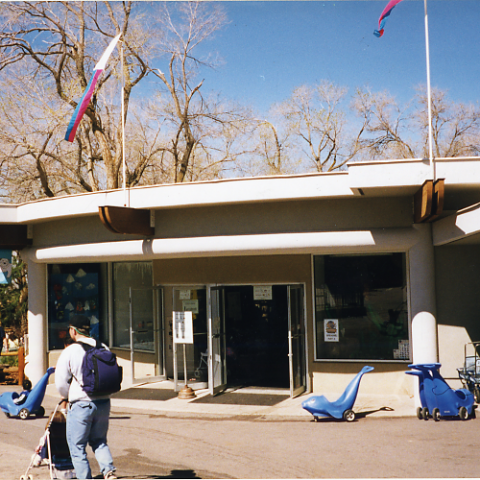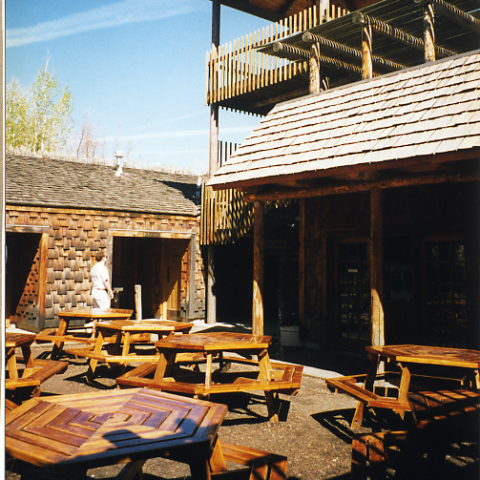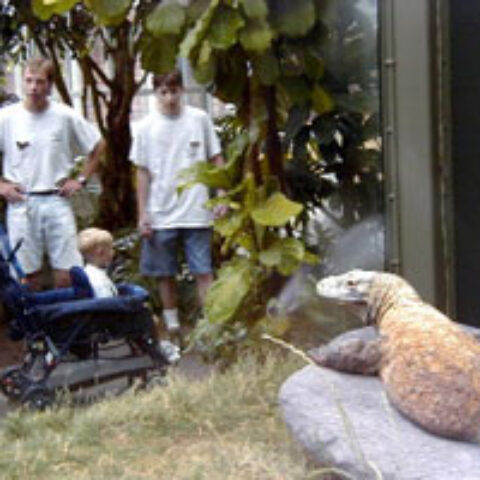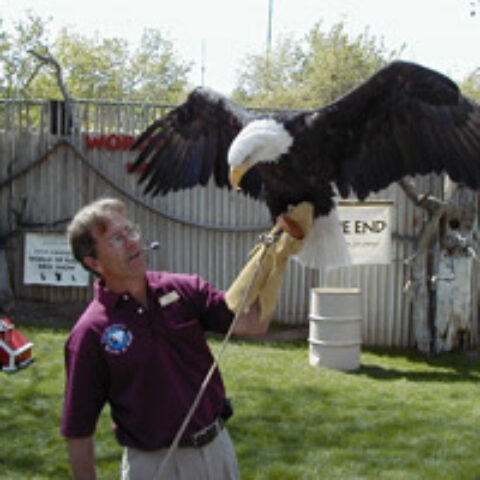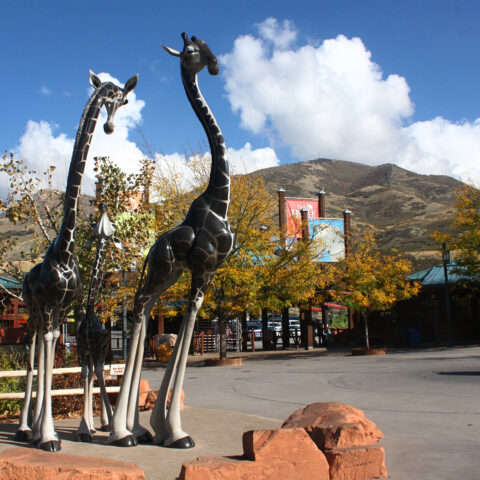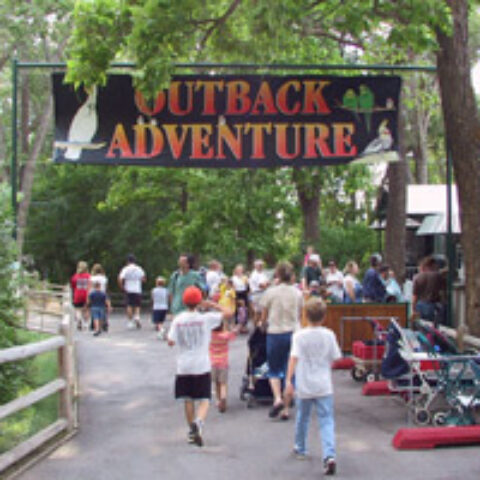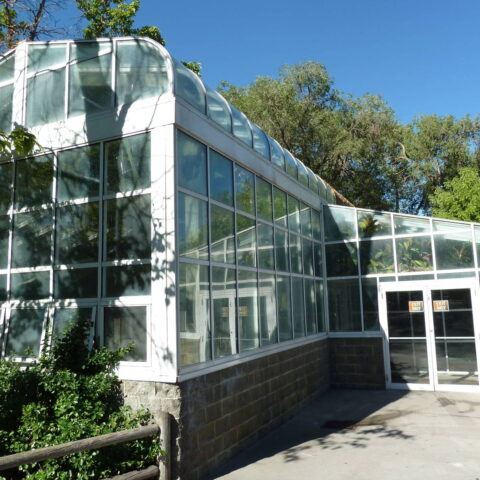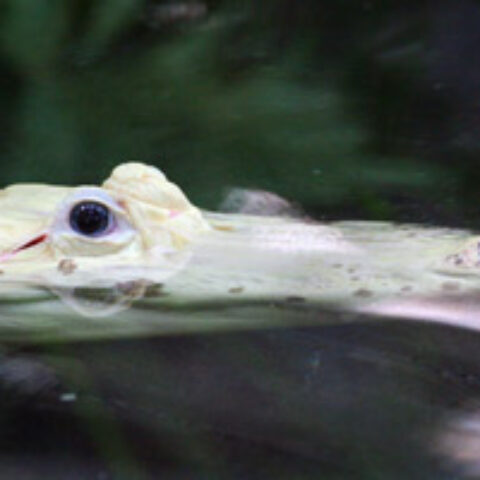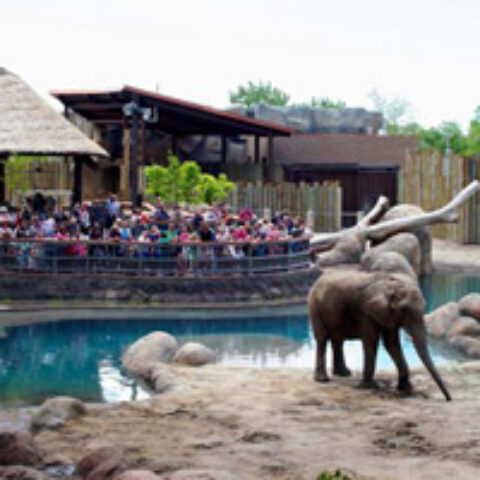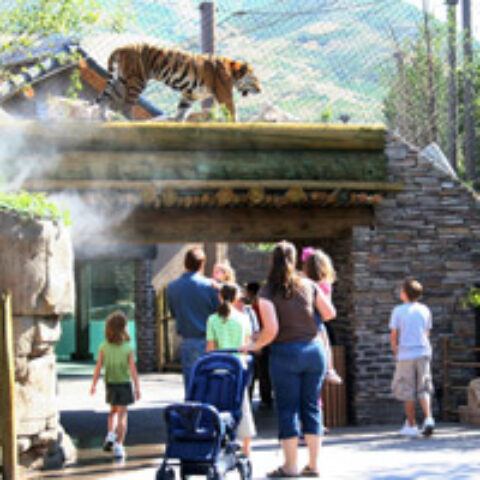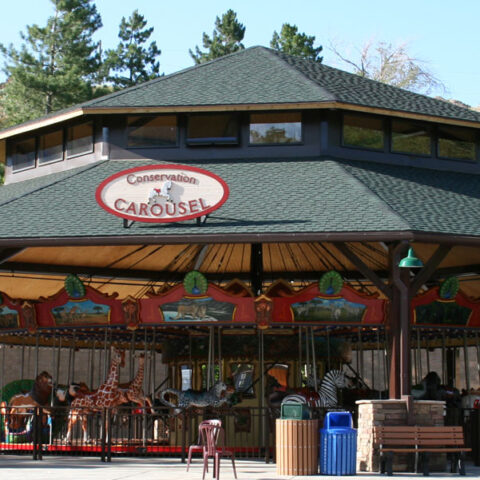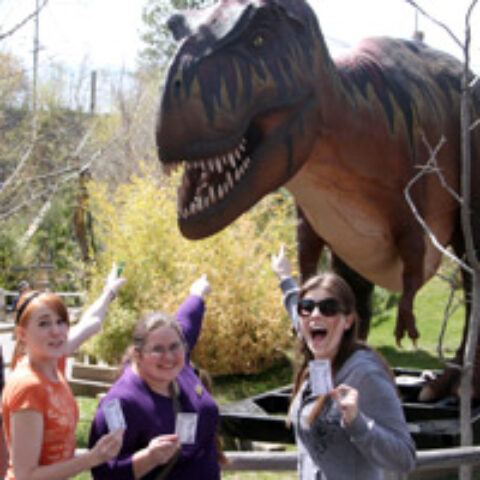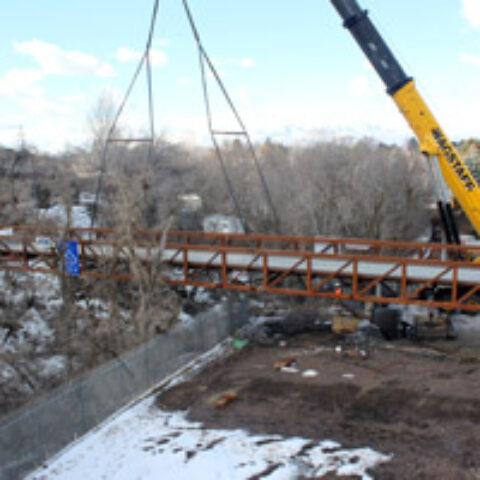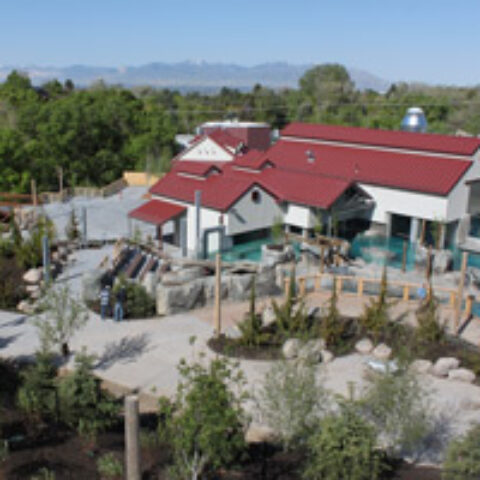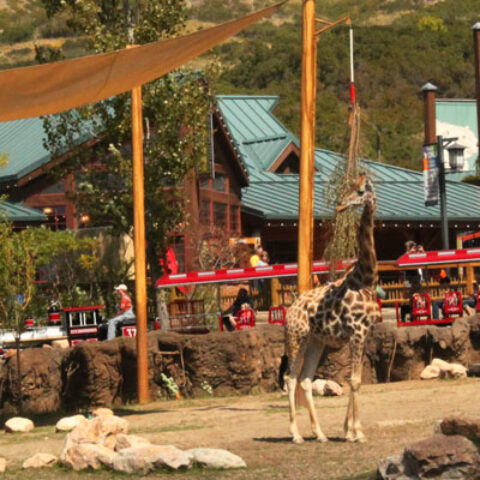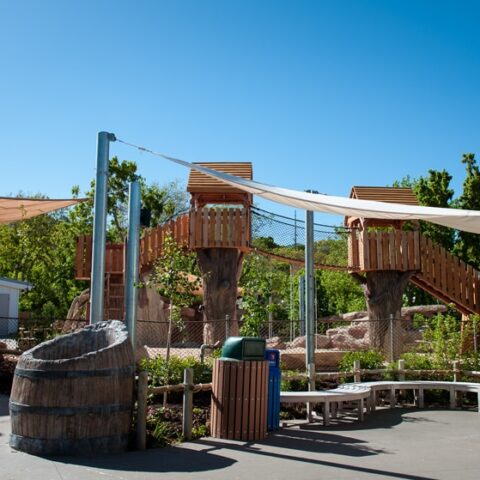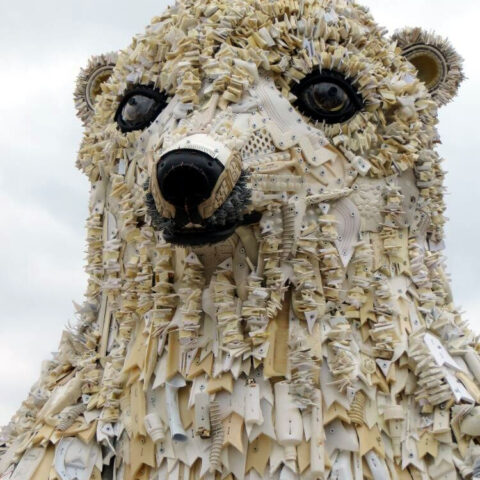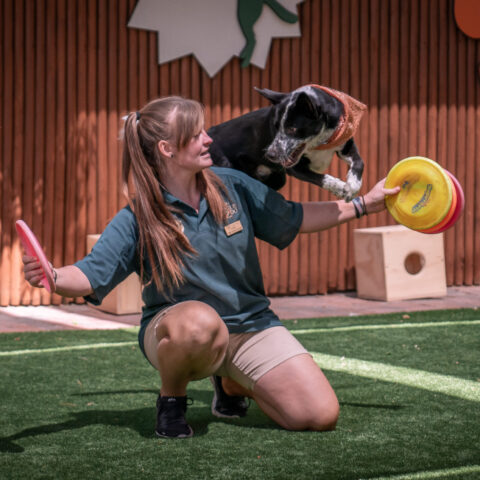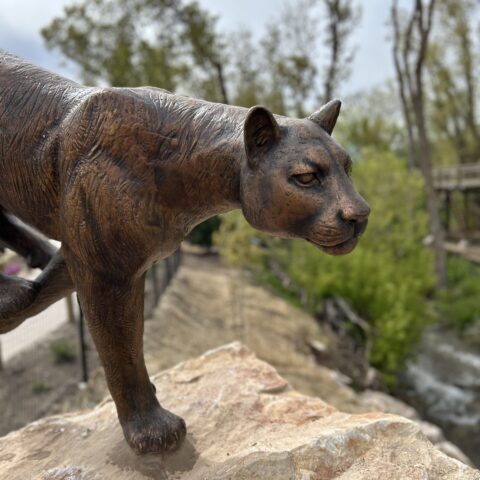Zoo History

Always Evolving

Utah Zoological Society was founded in 1911 on a small plot of land inside Liberty Park. Utah’s Hogle Zoo’s current location, at the mouth of Emigration Canyon, was generously donated by the Hogle family in 1931 and stretches over 42 acres of natural hillside terrain. Explore below and learn about Utah’s Hogle Zoo’s amazing 90-year history.
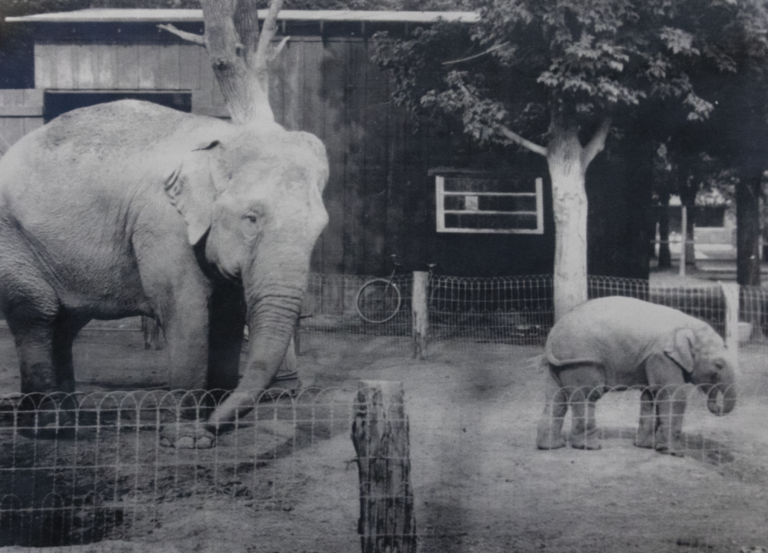
20th Century 1911 - 1999
1911 Liberty Park displays an exhibit of monkeys and later, acquires a deer for the exhibit. The deer proved so popular that the idea of having a Salt Lake zoo is enthusiastically promoted.
1912 The Salt Lake Parks Department officially establishes a zoo with an original investment of $153. The zoo’s inventory included:
One pair golden pheasants | One pair mandarin ducks |
One pair foxes | One pair demoiselle cranes |
One pair squirrels | One pair blue peafowl |
One pair white storks | One pair white-faced ring-tail monkeys |
1913 The zoo opens the “Happy Family Building”, which houses mostly birds. Included are quail, peacocks, pigeons, parakeets, ostriches, ducks, and a single turkey. The “Happy Family Building” is also home to over 100 rabbits and many guinea fowl. The zoo opens mid-May and closes mid-December. Visitors are admitted without charge.
1916 The zoo purchases the first elephant, “Princess Alice”, a 32 year-old Asian elephant named after Theodore Roosevelt’s daughter Alice. Penny and nickel donations from area schoolchildren raise $3,250 for Princess Alice’s purchase from a traveling circus called the Sells-Floto Show Company. The zoo’s animal inventory now includes more than 275 animals, 26 of which are donated. Except for the monkeys and Princess Alice, most of the zoo’s collection is from North America. In addition, 1,000 carp, 36,000 trout, 150 rabbits, 42 quail, 100 mallard ducks help make up the collection. The zoo’s annual budget is $4,788 of which $1,358 is spent for the animal’s food.
1917 The Zoo erects a building to house Princess Alice in Liberty Park.
1918 Princess Alice gives birth to “Prince Utah,” her fourth offspring, on April 29. Area newspapers herald the “blessed event.”
1919 Prince Utah sadly passes away on March 14. Newspaper sources report that an autopsy discovered that Prince Utah passed due to cardiovascular health complications. The elephant was then stuffed by a local taxidermist and placed on display.
1931 The community is in an uproar: Princess Alice breaks free of her enclosure too frequently and is repeatedly seen wandering 7th East – often “wearing” on her back an assortment of clothing from the neighborhood clotheslines. Community leaders begin talking about a new location for the zoo – and a new compound for Princess Alice.
Mr. and Mrs. James Hogle donate a parcel of land at the mouth of Emigration Canyon – which is where Utah’s Hogle Zoo is located today.
In February, the Salt Lake Zoological Society is formed to “provide direction and funding,” to assist in the acquisition of animals and the general development of the zoo’s grounds. All work of beautification, preparing fences, moats, ponds, and animal houses donated or paid for by donation. During the Great Depression, the Zoological Society sold flowers to raise money to feed the animal collection. On July 31, the zoo’s “Main Building”, the old Elephant Building now the location of our Lion exhibit, is dedicated to the children of Salt Lake. On August 1, the zoo opens to a whopping crowd of 14,000 people, many of whom arrived by public bus. Later that year, the first Monkey Island is constructed – near the site of the current Primate Forest exhibit.
1932 On August 14, a stone carving of Princess Alice on the front of the “Main Building” is unveiled and dedicated (see the carving in the Historical Photos section). Local sculptor J.R. Fox donates the carving. Building materials are contributed by the Zoological Society and area businesses.
1934 The water supply at the zoo is cut off for failure to pay a $195 bill. The Zoo’s flamboyant superintendent threatens to turn all the animals loose if the water is not turned back on. (The water was restored and the animals remained in their exhibits.)
1941 By 1941, the zoo was in dismal repair. Both the Depression and the financial resources needed to enter World War II had seriously affected the zoo’s financial stability. Few people – only those unfamiliar with the zoo’s condition – visit. In June, the Salt Lake Tribune publishes news articles about the zoo’s deplorable conditions. One article’s headline, published June 19, sums it up: “Bad Odor, Old Cages, Garbage – That’s Salt Lake City’s Zoo.” Salt Lake City commits to clean up and repair the grounds and facilities.
1942 Within the year, Salt Lake City improves the zoo, prompting a newspaper article that suggests that Duke, the zoo’s oldest lion, passed away “due to the shock of living in new, clean, comfortable quarters.” The zoo appeals to the public to donate unwanted pets.
1943 World War II rationing prompts the zoo to grow vegetables, wheat, and oats to feed the animals. Acreage at Salt Lake City’s Jordan Park is also used to raise vegetables for the animals.
1944 Mid-December, it is reported that Princess Alice has a “stomach ache.” Within days, the much-loved elephant suffers from a “nervous infection” which leaves her partially blind, but by the end of December, the elephant completely recovered.
1945 The zoo builds pathways, bridges, and new exhibits. For the first time, murals are painted on display walls. The “Main Building” is renovated inside.
1946 The zoo is visited by experts and acclaimed “a fine zoo.” In November, “Blizzard,” the zoo’s 8-yr-old polar bear, is non-fatally shot by an unknown guest. The culprit is never caught. The zoo’s superintendent announces that hereafter, firearms found on zoo visitors will be confiscated and punitive measures will be taken against people who throw sticks or stones at the animals. (The bullet wound, between the bear’s eye and ear, was not fatal and the bear lived another five or six years following the incident.)
1947 Renowned Utah sculptor Dr. Avard Fairbanks sculpts two mountain lions atop 18-foot granite columns and the zoo’s old entrance is erected. These same statues can still be seen today in the entrance fountain. Princess Alice escapes yet again, forcing her building’s doors open and running through a fence and the gardens. The elephant rips up a concrete and steel drinking fountain and uproots a Chinese Elm tree. Later, the elephant calmly returns to her quarters.
1948 On May 14, a female “Liger,” sired by a father lion and mother tiger, is born. Eventually, the liger is famously named Shasta.
1951 The Utah Zoological Society is formally organized, replacing the Salt Lake City Zoological Society, which had not been functioning for 10 years.
1953 Princess Alice, at an approximate age of 69, becomes ill and is humanely euthanized.
1956 – 1962 The zoo constructs a cougar exhibit, grotto for the zoo’s bears, an island for macaws, a children’s petting area and penguin display. The zoo also constructs a new monkey island.
1964 Zoo Director Gerald deBary is fatally bitten by a puff adder and LaMar Farnsworth is named director. The zoo constructs a sea lion pool and dedicates it to Mr. deBary. Hogle zoo begins research regarding snake venom.
1965 – 1966 The Tapir building and the Great Apes Building are constructed. The zoo’s first three chimpanzees are acquired through donated trading stamps.
1968 – 1969 The zoo constructs a “South American Area” and a unique, two-level giraffe building. The zoo replaces an old 45 – passenger train with a replica of the “C.P. Huntington,” an 1860 steam train owned by California Governor Leland Stanford. The cost of the train: $25,000 plus an additional $25,000 for the tracks.
1970 – 1981 Hogle Zoo’s most popular animal, Shasta the Liger, passes away due to old age in 1972. The zoo opens the airy Feline Building; the Small Animal Building with tropical, desert and temperate zones. The Hippo Building, a wolf run, a snowy owl exhibit, and a camel display area are among the zones on display. The zoo celebrates its 50th anniversary by opening the Animal Giants Complex for elephants and rhinos, and a state-of-the-art animal hospital. The east end of the old elephant building is remodeled into an auditorium.
1982 Salt Lake County, agrees to help fund the operating expenses of the zoo. The Utah Zoological Society recommits to providing revenues for management and capital improvements. Society members and other donors fund the construction of the red kangaroo exhibit, the colobus and spider monkey displays, and the pronghorn antelope area.
1983 – 1985 The last of the old cage-like exhibits, constructed in the 1930’s, are demolished. The zoo completes new exhibits for endangered snow leopards, primates, and great apes. The Utah State Legislature recognizes the zoo as a state revenue-enhancing attraction and commits an annual grant to the zoo’s operating expenses. The zoo officially becomes Utah’s Hogle Zoo.
1986 – 1989 Through private donations and memberships, the zoo opens the old African Savanna exhibit and a gazelle exhibit at the far west end of the zoo (currently where the Rocky Shores Bear enclosures are located), renovated primate areas, and the first three phases of the kid-friendly Discovery Land playground at the east end of the zoo. Attendance tops 600,000 and in 1989, over 652,000 people visit Utah’s Hogle Zoo.
1990 Three more phases of Discovery Land open: Prairie & the Predator, Knoll & Burrow, and Marsh Aviary. Gorgeous, the zoo’s 41-yr-old gorilla has a cataract removed and a lens implanted by Dr. Allan Crandall, an ophthalmologist at the University of Utah Medical School. The surgery and lens are donated. Gorgeous can see, is more active, and adjusts well to her new life. The zoo’s oldest resident, Kali, a 46-yr-old Asian elephant, suffers from a continuous foot ailment and has an orthopedic shoe custom made. Kali rips it up in no time and her paddock is remodeled with a cement floor to keep dirt and pebbles out of her foot pads.
1991 The zoo kicks off its’ 60th anniversary celebration on July 31 with the unveiling and dedication of the Hogle Monument, a bronze elephant bust sculpted by Salt Lake artist John Mortensen. This statue can still be seen today across from the Rendezoo Room. Fellow trustees of the Utah Zoological Society, Zoo staff, friends and four generations of Hogles recognize James E. Hogle, Sr.. A time capsule is buried by Director LaMar Farnsworth, Governor Norman Bangerter and James E. Hogle, Jr., and the month long celebration continues through August. The Utah State Legislature recognizes the zoo’s 60 years of service to Utah communities by passing a resolution commemorating the zoo’s 60th anniversary. Elaine, one of the zoo’s first gorillas, moves to the Toledo Zoo, where she is placed with males who can produce offspring, since attempts to breed her with two other gorillas at Hogle Zoo were unsuccessful. Attendance tops 716,000. Admission is $4.00 for adults, $2 for children 5-14 and seniors, and children under 5 are free.
1992 The fifth and final phase of Discovery Land, the Desert, is completed marking the completion of the $2.5 million development at the east end of the zoo. Zoo attendance tops 750,0000.
1993 Utah’s Hogle Zoo opens a temporary exhibit, “Dinosaurs Alive!” featuring 17 life-sized robotic dinosaurs. Attendance to the exhibit reaches 266,751 and total attendance to the zoo is a new record of 789,000. The zoo increases admission prices to $5.00 for adults and $3.00 for children.
1994 Utah’s Hogle Zoo opens its new gift shop, “The Flamingo Zootique” in April. The zoo’s summer attraction, a rare white alligator, is displayed from July – September. Unseasonably hot weather dramatically reduces attendance to Utah’s Hogle Zoo by 21%. First annual Art Show hosted, featuring local artists and works on the natural world.
1995 The AZA Western Regional Conference is hosted by Utah’s Hogle Zoo. “World of Flight” bird show, hosted by Steve Chindgren, makes its debut, running from Memorial Day to Labor Day. Butterfly World, a green house housing butterflies, emerging boxes, and chrysalids opens to the public. Remodeling begins on the small feline exhibits in the Feline Building.
1996 Remodeling is finished on the small feline exhibits, which now include murals. Phase I of the “A. LaMar Farnsworth Primate Forest” opens to the public, housing the colobus monkeys. Monkey Island is torn down to make way for phases II and III of Primate Forest. Warthogs are on display from Memorial Day to Labor Day; black-footed ferrets and zebras arrive; the sea lion exhibit is remodeled to become the Penguin Cove.
1997 After 43 years as director, A. LaMar Farnsworth retires, and Craig Dinsmore becomes Executive Director. Phases II and III are completed on the Primate Forest. Dinosaurs are back, with “Zoorassic Jungle,” which, along with the birth of twin polar bear cubs Koluk and Kiska, gives the zoo record attendance of 821,458. New offices are built for Marketing, Graphics, and Development. The zoo hires its first Development Director. Gorgeous, a 48 yr.-old gorilla, becomes the oldest gorilla living in human care. Fourth year of the art show and third year of the “World of Flight” bird show.
1998 The main concession stand is remodeled to be more time and cost efficient. It is now a walk-in, self-serve stand called “The Beastro,” (now the current Education building). Work starts on a new parking lot, which will include a stone wall and planters, and the main restrooms are enlarged. Unseasonably cool weather brings a slow spring and summer. The first gala, “Rendezvous In The Zoo” raises over $100,000 for the zoo, and brings fund-raising in Utah to new heights. Strategic Planning and Master Planning are now under way, which gives the zoo a 10-year plan for remodeling.
1999 Admission prices are changed to Adults (13 – 64) $6.00, Children (3 – 12) and seniors $4.00, and children 2 and younger are Free. The 6th annual art show is a tremendous success, and the perennial favorite, The World of Flight Bird Show, returns as well. Twin polar bear cubs, born on Thanksgiving of 1998, debut in mid-April. A Komodo Dragon is on display from Memorial Day to Labor Day, housed in the Tropical Gardens.
21st Century 2000 - Present
2000 On July 17, 2000, the zoo officially broke ground for a new Entry Complex, the first project of the new Master Plan. Two koalas are on loan from San Diego Zoo through the summer.
2001 “Butterflies!” debuts in Tropical Gardens and Utah’s Hogle Zoo opens a much-anticipated new Entry Plaza. The Entry Plaza is made up of a new Wild Zootique gift shop, Membership and Guest Services, a new train station and an Events Pavilion. Anana, a female polar bear, born on December 12, 2000, makes her public debut in April. Admission prices increase to $7 for adults and $5 for children 3 – 12 and senior citizens.
2002 The year started off with a bang, as the 2002 Winter Olympic celebration concluded with the state’s largest ever firework display just across the street. The American Association of Zoo Keepers (AAZK) awarded the zoo’s behavioral enrichment co-coordinator with their first ever Environmental Enrichment Award. The award recognizes outstanding keeper-initiated contributions to the art and science of environmental enrichment. “Outback Adventure” temporary exhibit opened in May. The exhibit, featuring over 300 free flight birds from Australia, gave guests the chance to feed and interact with the birds. This is the most interactive exhibit the zoo has ever presented. Two black bear cubs, orphaned in the wilds of Minnesota, debuted in July. A golden lion tamarin and a giraffe were born in September. Two female red pandas made their debut in December.
2003 Amur (Siberian) tiger cubs were born in February. Salt Lake City voters pass Proposition #1, “Redo the Zoo” campaign in November, giving the zoo $10.2 million to refurbish the elephant and feline habitats. The World of the Wild Art Show celebrates its 10th year. Outback Adventure returns for a second year. The zoo announced the tragic passing of the zoo’s only polar bear, Andy. He died Wednesday, November 26, 2003 after ingesting a guest’s adult size glove.
2004 Kali, the zoo’s only Asian elephant, dies. At 59 years of age, Kali was the third oldest Asian elephant in North America and had been at Utah’s Hogle Zoo since 1954. A groundbreaking ceremony for the “Elephant Encounter” exhibit happens in June. It is the first project of the “Redo the Zoo” campaign. A new “Wildlife Theatre,” a 450-seat outdoor theater, opens in June. The theater hosted the ever-popular bird show, as well as several evening concerts. Four Chacoan peccaries arrive in July. The endangered animals make their home in a newly refurbished exhibit next to the Bear Grotto. The zoo again receives accreditation from the American Zoo and Aquarium Association (AZA) in September. Accreditation is granted for a five-year period and is awarded following an extensive application process. The “Outback Adventure” exhibit closes in September after a successful three year run. Salt Lake County residents face re-authorization of the Zoo, Arts, and Parks (ZAP) tax. Utah’s Hogle Zoo, along with the ZAP re-authorization committee, hosts ZAP Appreciation Day at the zoo. The day is highlighted with performances, demonstrations, exhibits, and arts from various ZAP recipients. ZAP is overwhelmingly approved, receiving 71 percent of the vote.
2005 In March, the Board of Directors approved an increase in admission prices and membership prices. Admission increased to $8 for adults, $6 for children (ages 3-12) and seniors 65 and older. Children 2 and younger receive free admission. On Mother’s Day, May 8, a baby orangutan is born via c-section. Since her mother does not recognize the baby as hers, staff and volunteers take on the around-the-clock duties of caring for the baby. Staff works tirelessly throughout the year to reintroduce the baby to her mother. The current Elephant Encounter, the largest, new animal exhibit in 25 years, opens to rave reviews in June. The exhibit, featuring three female African elephants and two white rhinoceros, provides a stimulating, updated environment for the animals by enhancing and increasing the habitats, activities and surrounding areas while providing better viewing areas and educational opportunities for the guests. “Butterflies!” returns in Tropical Gardens as the summer special exhibit. Construction begins on the current Asian Highlands exhibit. This is the second project funded by the 2003 Salt Lake City General Obligation bond. The exhibit is scheduled to open in the summer of 2006. The zoo receives the 2005 Thomas A. Martin Utah Recycler of the Year Award from the Recycling Coalition of Utah. The award recognizes the zoo for being environmentally conscious, caring about recycling and helping to make a difference in our community and environment. The second highest attendance in zoo history is recorded with 800,521 visitors enjoying the zoo.
2006 The zoo instituted a marketing plan in January to celebrate the 75th anniversary of the zoo at its current location. Monthly activities and discounts were held. After several delays in scheduling a grand opening due to construction delays, on June 29, Asian Highlands opened to rave reviews. Asian Highlands is phase three of the master plan and the second of two projects funded by the 2003 Salt Lake City General Obligation bond. On July 10, a retrospective of the zoo’s history as part of its 75th anniversary celebration opened in the auditorium. A highlight was the return of the taxidermied Shasta the liger, on loan from BYU. The retrospective was popular with members and guests and three “memory books” were filled with guest memories of the zoo. Butterflies! returned for the second consecutive year in the Tropical Gardens building. Acara the baby orangutan celebrated her first birthday on May 14. A female grey wolf escaped on Mother’s Day, May 14. The Zoo had to be evacuated late in the afternoon. The wolf was humanely darted shortly after and returned to her exhibit with no incidents. Abby the lion dies of complications of old age in late December. Intermountain Contractor magazine’s “Best of 2006” issue honored Hogle Zoo with it’s award for “Best Public Project Under $5 million” for the zoo’s newest addition, Asian Highlands. Hogle Zoo achieves record attendance with 847,831.
2007 The zoo debuts the “Ghost of the Bayou” in early May – a white alligator exhibit inside the Tropical Gardens greenhouse. A successful artificial insemination procedure was completed on Christy, the African elephant in the spring by the team from Germany. A Disneymania! Concert for Conservation took place on July 11 to raise money for Utah’s Hogle Zoo and AZA conservation efforts. Utah’s Hogle Zoo is one of only 10 zoos nationwide selected via submitted proposals to participate. Two cheetahs make their debut in late June. A campaign was initiated to put a $65 million bond on the county ballot. ZooLights, a new holiday-themed lighting event debuts in December, pulling record attendance.
2008 Christy, one of the Zoo’s elephants, is determined to be pregnant in February. This was the third of three attempts to artificially inseminate by the team from Germany. A new carousel, titled the “Conservation Carousel” opens to the general public in June located at the former area of the Hippo Building. The “Ghost of the Bayou”- the popular white alligator exhibit in tropical garden – is extended through the fall. Muke, a female gorilla, undergoes successful surgery for a hysterectomy by a team of physicians to help in her battle with cancer. The zoo hospital team assisted in the surgery. Dari at Utah’s Hogle Zoo becomes the oldest living African elephant in a zoo in the country. Eli, a howler monkey, undergoes successful cataract surgery performed by a local ophthalmologist and assisted by the zoo hospital team. “Boo at the Zoo” on Saturday, October 25 sets an all-time one day attendance record: 23,479. The previous record was in excess of 17,000 during a ZCMI free day in 1983. Salt Lake County voters passed Proposition #2 “Renew the Zoo” in November which will bring $33 million to the Zoo for exhibit refurbishment. For the third consecutive year, Utah’s Hogle Zoo achieves record attendance – 996,070.
2009 The 2008 recession forces Utah’s Hogle Zoo to make cuts in the operating budget. Muke, the Zoo’s popular and beloved 44-year old female western lowland gorilla, loses her fight with cancer in March. Muke had been a resident at the zoo since 1996. Madagascar! is the zoo’s newest temporary exhibit to be housed in the Tropical Gardens greenhouse. It features two fossa, tenrecs, tree boas, hissing cockroaches, and radiated tortoises. It is the summer of babies at Utah’s Hogle Zoo! Two GLTs debut on Mother’s Day, A male snow leopard cub is born on May 7, three male tiger cubs are born on June 2, a rare Siamese crocodile is born, a giraffe is born on July 30, also meerkats, prairie dogs and a howler monkey. The most celebrated birth occurred on August 10 when Christie the African elephant became a first time mom with the birth of a healthy female calf. A naming contest was conducted and Zuri, the baby elephant, debuted to the public on Friday, September 11. The new LS Skaggs Animal Health Center officially opens in November, offering a new state-of-the-art animal health facility. The third annual ZooLights welcomes 35,068 guests. The zoo draws over one million guests for the first time ever in 2009. The millionth visitor entered through the Zoo gates during ZooLights on December 17. For the fourth consecutive year, Utah’s Hogle Zoo achieves record attendance – 1, 022,066
2010 The zoo begins designing and planning on Rocky Shores exhibit, scheduled to open in the spring of 2012 on the west end of the zoo, the area formerly occupied by the previous African Savanna. Nature’s Nightmares! opens to the public in the Tropical Gardens greenhouse on Saturday, May 16. Husani, a Male western lowland gorilla arrives from Birmingham Zoo in May.
Great ape staff begins slow introduction of Husani with Tino in June in order to form a “bachelor troop.” Dari, considered the oldest African elephant in North America, celebrates her 50th birthday in June with a public event. Utah’s Hogle Zoo keeper staff, at the request of the Utah Division of Wildlife and Chevron Oil, take on the task of cleaning and caring for over 100 water fowl following the oil spill on June 12. Zuri, the female African elephant born in 2009, celebrates her first birthday on August 14. A large crowd wished her happy birthday at a special public event. All animals removed from the west corner of the zoo by August 23 in preparation for construction of Rocky Shores. Demolition of site began shortly thereafter. ZooLights! adds live reindeer and a Santa meet-and-greet. Attendance is 37,590 – the second highest in the event’s four year history.
2011 Construction continues on Rocky Shores in first quarter. The new bridge is moved to the permanent site over Emigration Creek on Friday, March 11. Large-scale, animatronic Dinosaurs arrive on Monday, May 2 for the Zoorassic Park summer event beginning May 14. Tropical Gardens greenhouse building is demolished in early September to make way for the new Beastro with indoor eating space. Ground broken for new Conservation Resource Center Administration building on zoo’s south ridge in early September. Utah’s Hogle Zoo welcomes the arrival of two female gorillas in the summer. The 5th Annual ZooLights event welcomes 63,916 revelers – a new attendance record. The old record set in 2008 was 44,337. Utah’s Hogle Zoo welcomed its one millionth guest for only the second time in our history on Wednesday, December 28 Utah’s Hogle Zoo achieves record attendance in 2011 for the fifth time in six years with 1,023,696 guest visits.
2012 The Rocky Shores exhibit opens to rave reviews on June 1. The zoo welcomes back a polar bear, Rizzo, and three sea lions, Big Guy, Rocky and Maverick. The zoo also welcomed three grizzly bear siblings that were orphaned. Snow leopard cub born, April 16. Construction begins on a new Maintenance Operations Building (MOB) on the former site of the old Giraffe building. The new Beastro cafeteria opens in April to replace the old Beastro, now the education building. It offers indoor seating for the first time in the zoo’s history and is considered the zoo’s main concession building. 214,000 visit the zoo in the month of June, the most people to visit the Zoo during a 30-day period in the Zoo’s history. The new Conservation Resource Center Administrative building begins functioning as an office on July 25. The old Elephant building and Discovery Land playground areas are demolished for construction of the new African Savanna exhibit, September 17. The Zoofari express also closes as the train tracks are re-routed with the new exhibit. One million in attendance achieved on Sunday, October 7. 76,208 attended the sixth annual ZooLights – a new record
2013 A temporary LEGO exhibit, “Creature of Habitat: A Gazillion-Piece Animal Adventure”, leased from the Philadelphia Zoo, debuts on April 24 to large crowds. Big Guy, the Zoo’s popular blind California sea lion, passes away on Monday, July 8 due to urogenital carcinoma with metastasis, a cancer common among sea lions. Lighthouse Point splash pad opens on August 1. Boo at the Zoo achieved attendance of 15,220, the second highest attended Boo event in its 25 year history. Utah’s Hogle Zoo hosted the 2013 American Association of Zoo Veterinarians (AAZV) annual conference, September 27 – October 4. A painting by Christie elephant was presented to former president George W. Bush in May. Final 2013 attendance: 1,051,413 – the fourth largest in the Zoo’s history.
2014 Hogle Zoo opened a new lion exhibit, as part of the new African Savanna exhibit, on May 2 to rave reviews. Utah’s Hogle Zoo opened the grasslands portion of the African Savanna on May 30. Preparations begin for Hogle Zoo to host the 2015 annual Association of Zoos & Aquariums (AZA) conference. The World of Flight Bird Show celebrates its 20th anniversary at Utah’s Hogle Zoo. Eli, a male orangutan died of complications due to breast cancer in September. He was diagnosed in May of 2011. Tuah, a male orangutan was born on November 4 by c-section. Eve, his mother died from complications not long after his birth. The dedicated team of primate keeper staff worked around the clock for weeks caring for Tuah, until they were able to turn him over to the care of his big sister, Acara. ZooLights, now in its 8th year, celebrates the highest record attendance of 96,822. Final 2014 attendance is 1,219,309 – the second largest in the Zoo’s history.
2015 Zoorassic Park 2 opens to rave reviews on Friday, May 1. It includes 14 animatronic dinosaurs representing 11 species. There are over 13 individual sponsors, including the presenting sponsor, Les Schwab Tire Centers and a major contributor, the Natural History Museum of Utah. Construction begins for the new Creekside boardwalk project, replacing the deteriorating primate forest buildings and “monkey spheres”. In April, Tuah, a baby orangutan, debuts to the public. In early August, Dari, the oldest African elephant in North America, passes away of old age at the age of 55. Utah’s Hogle Zoo is proud to host the annual conference of the Association of Zoos & Aquariums at the Salt Palace in September. Final ZooLights attendance is 64,506 – the third largest in the event’s history. Final Zoo attendance is 1,132,676 – the third largest in the Zoo’s 84 years.
2016 Creekside opens in May featuring a new amphitheater, an expanded playground and walkways near Emigration Creek. In January, a female giraffe is born to Pogo and Riley, and named Willow. 18,707 attend the February Wild Wednesday free admission event, the second highest one-day Zoo attendance total since records have been kept. A set of three (3) African lion cubs, Brutus, Titus, and Calliope, are born to mother Nabu and father Baron on Wednesday, February 24. Rocky, a male sea lion, passed away in late April of causes related to health concerns he had before arriving at Hogle Zoo in 2012. Creekside Discovery Theater was dedicated in May in memory of a young boy named Wyatt Fricks. Creekside Play Area ribbon cutting ceremony took place on May 12. The three lion cubs, Brutus, Titus and Calliope, debut to the public on Monday, May 16. Daphne, the oldest giraffe in North America, passed away in May of health issues incident to age. Zeya, a 60 lb female Amur leopard left her outdoor yard at habitat #3 on June 7 and was found asleep on a ledge 10 feet above the public viewing window. Once the cat was discovered and her location confirmed, the zoo’s emergency protocol was immediately initiated. The cat was darted successfully with a sedative, crated and moved to the indoor holding area within Asian Highlands. The community applauded the professionalism and calm manner that the zoo’s emergency response team handled this rare incident. The first ever Zoo Brew events occur. Staff celebrates the Zoo’s 85th birthday on August 1 with cake for guests and staff. At the annual conference of the Association of Zoos & Aquariums, Utah’s Hogle Zoo was honored along with eight sister institutions with the Association’s International Conservation Award. The award recognizes exceptional efforts by AZA member institutions toward habitat preservation, species restoration and support of biodiversity in the wild. Utah’s Hogle Zoo was recognized for its partnership with G.R.A.C.E – Gorilla Rehabilitation and Conservation Education Center. BooLights, a new Halloween light event similar to the popular December ZooLights event, debuts and becomes a staple event. ZooLights celebrates its 10th anniversary.
2017 Temporary exhibit, BUGZILLAS!, opens in May, that includes 14 animatronic bug species. The Zoo welcomes, Diego a male sea lion from Indianapolis Zoo as part of the SSP. Two Amur leopards born in February, named Rafferty and Roman. Five Pallas cats born. Craig Dinsmore, Zoo President/CEO for 20 years, announces retirement in April and leaves the Zoo in October. Following a nationwide search, a new President/CEO is hired. Steve Burns begins his new duties on December 9. Polar bear Rizzo passes due to renal failure in April. Howard, a North American river otter arrives on April 25th through the recommendation of the SSP. Dr. Erika Crook was inducted into the European College of Zoological Medicine. The zoo raises over $200,000 for wildlife conservation programs worldwide. Wildlife Connections and Animal Art programs raised over $30,000 for conservation. Hope, a female polar bear, arrives from Toledo Zoo to be a mentor to Nora, another female, from Oregon Zoo. Both bears arrived in September to much media and public fanfare. In 2017, the outreach programs of the Zoo's Education Department reached nearly 43,000 teachers and students. 509 teachers from across the state participated in teacher workshops. Second annual BooLights achieves 13,979 in attendance. 11th annual ZooLights achieves 56,099 in attendance.
2018 Red Pandas triumphantly return to Utah’s Hogle Zoo with the Janet Quinney Lawson Red Panda exhibit. Due to construction of Rocky Shores in 2010, the previous Red Panda exhibit had to be demolished.
2019 Another traveling exhibit, Washed Ashore, opens during the summer months, featuring large, animal sculptures made entirely from waste that has “Washed Ashore” on various beaches. The exhibit highlighted and brought awareness to ocean clean-up and conservation efforts. The James E. Hogle, Jr. Meerkat Manor exhibit is completed as an extension of the African Savanna exhibit.
2020 The COVID-19 pandemic forces the zoo to close for 47 days on March 17, 2020. Utah’s Hogle Zoo was the first AZA accredited zoo to reopen with timed ticketing, capacity restraints, and a one-way path for guest safety. The zoo experiences its first ever reduction in employee workforce. Utah’s Hogle Zoo celebrates the birth of gorilla baby, Georgia, to father Husani, and mother Jabali. Guests required to reserve a time to view the baby gorilla to maintain social distancing inside the Great Apes building. Thanks to a generous state grant, the zoo’s annual ZooLights event is free for the general public for the 2020 season.
2021 Utah’s Hogle Zoo celebrates its 90th anniversary on August 1. Doug Lund is appointed as CEO by the Board of Directors after Steve Burns steps down. Amur Leopards Dimitri and Zeya give birth to cubs Sylas and Jordan, their fourth successful litter, named by a generous zoo donor. Beloved reticulated giraffe, Riley, passes at 18 years old. Amur tiger Cila also passes at 18 years old.
Amur tiger Sasha moves from the Rolling Hills Zoo in Kansas to Hogle Zoo. The Zoo's resident lion pride are diagnosed with Covid-19; all lions make a full recovery. The Zoo participates in a study with the Utah Department of Health and Centers for Disease control to better understand transmission. The Zoo releases western toads on the Paunsaugunt Plateau in southwestern Utah, as part of the State’s efforts to recover the species. Annual attendance makes a rebound to 882,388. Process to artificially inseminate female African elephant Zuri begins with a trial and attempt. Further training and testing needed.
2022 Snow leopards, amur leopards and tigers receive Covid-19 vaccinations through voluntary injections. The Zoo contracts with Stunt Dogs Productions to create the Canine Champions for Conservation seasonal dog show program for the Wildlife Theater. Female gorillas(from Busch Gardens Tampa), Mary and Pele join the Hogle Zoo gorilla troop. Construction officially begins on the Zoo’s next expansion, the Aline W. Skaggs Wild Utah exhibit, featuring various species of animals found Utah. The exhibit will be located on the East portion of the zoo, an area previously inaccessible to the general public. The new exhibit is slated to open in winter of 2023. The Zoofari Express train ride is closed to accommodate Wild Utah construction. Female giraffe, Reyna, is born to mother Stephanie, and deceased father, Riley. Lovingly dubbed “Riley’s Towering Legacy.” The Zoo begins working on a new 10-year strategic plan.
2023 Due to record snowfall, construction on Wild Utah is delayed and the opening is moved from winter 2023 to spring 2024. The Zoo creates an all-new strategic plan that includes 5 new priorities: Be the wildlife conservation leader in Utah, be financially sustainable for long-term growth, be a provider of excellent animal care and wellbeing, be a destination with a purpose, and be a zoo for all. Red panda, Priya, gives birth to cub Dorji. In May 2023, after a comprehensive evaluation, the Zoo makes the difficult decision to move African elephants, Christie, 37, and Zuri, 14, to the Kansas City Zoo & Aquarium where opportunities for them to grow their family may increase. Christie and Zuri spent months training with the keepers to be transported to their new home and departed the Zoo on October 17, 2023. The Zoo acquires sea lion, Finn, on loan from Denver Zoo. Sanura, the oldest black footed cat in AZA zoos, passes at 18 1/2 years old. Red Panda, Priya, passes due to health complications. Cub Dorji and Mow Mow continue to thrive. The Zoo receives the Utah Green Business award for water-saving, recycling, and sustainable practices. Hal (Haru), the Pallas Cat, passes of old age, giving birth to 10 kittens in the past and made a big impact on the Pallas cat survival program. The Zoo acquires two Mongolian wild horses, Dimitri and Mikhail, and moves a bachelor herd of zebras to reside in the vacant yards inhabited by the elephants. ZooLights attains record breaking attendance of 49,507.
2024 Red panda cub, Dorji, departs to Connecticut's Beardsley Zoo as part of a recommendation by the Red Panda Species Survival Plan (SSP). The new Aline W. Skaggs Wild Utah exhibit opens to the public on Thursday, May 9 with much fanfare. The new exhibit on the east end of the Zoo is 3 acres and cost $22M to build. Thanks to the generous support of the George S. and Dolores Doré Eccles Foundation, the newly named Eccles Express train ride also reopens with a new electric locomotive. Wild Utah features animals commonly found in Utah such as cougars, bighorn sheep, a bobcat, a badger, marmots, North American porcupines, and more. Many of the species were rescued in partnership with the Utah DWR. The Canine Champions for Conservation dog show returns May 11 for their third season at the Zoo. The former Elephant Encounter exhibit is renamed to High Desert Oasis, highlighting various ungulate species found in high desert climates of Asia and Africa. Western lowland gorilla, Pele, gives birth to baby boy, Addo (Ah-Doh) in June. Snow leopard, Babs, gives birth to two cubs, Pavlova and Bhutan, in June. The zoo celebrates 801 Day and 93rd Anniversary on Thursday, August 1 with an attendance of over 12,000 guests.
To be continued...
